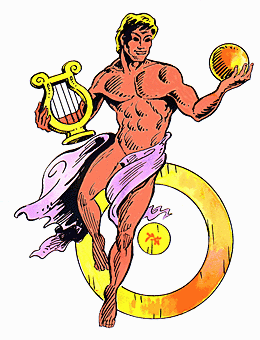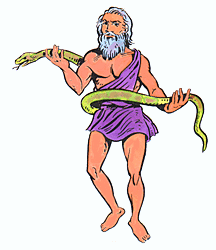Apollo, Greek Myth: god of the Sun
Apollo, the Sun god, brings life-giving heat and light to Earth.

As patron god of musicians and poets, he carries a lyre and his symbol represents the “egg of creation”.

- Apollo was associated with law, philosophy, and the arts. He sometimes gave the gift of prophecy to mortals whom he loved, such as the Trojan princess Cassandra.
- One of the most important Olympian gods; son of Zeus and Leto, twin brother of Artemis.
- He is considered the ideal of manly beauty, so that a very handsome man might be called an “Apollo”. He is also the god of poetry and music.
- Apollo replaced the Titan Helios as the sun god; however, the Greeks didn’t delete Helios completely but referred to both of them as the Sun gods.
- The arrows of Apollo and Artemis invariably killed and the Greeks explained epidemics of diseases by supposing that they were sooting at people; and so, by praying to Apollo, the epidemic might be made to stop. In this way, Apollo became associated with the cure of diseases.
- Such so-called cures led to a myth in which Apollo was thought to have had a son, Asclepius (as KLEP ee uhs), who is better known under the Roman version of the name, Aesculapius (es" kyoo LAY pee uhs).
- He was a mortal medical healer who was so successful that he was reputed to have the ability to bring the dead back to life; which resulted in complaints by Hades. As a result, to keep peace in the godly family, Zeus killed him with a thunderbolt.
- After his death, Aesculapius became a god and he was also placed among the constellations, where he is pictured as a man holding a serpent in his hands (similar to the following image).

- The snake was a symbol of medicine and doctors and the Latin name for his constellation is Ophiuchus (oh fee YOO kuhs) which means “serpent-holder”.
- Sometimes the stars forming the serpent are referred to as a separate constellation called “Serpens” (serpent) and occasionally the whole constellation is referred to as “Serpentarius”.
- Apollo became significant among the Romans when Augustus Caesar, as a young man, chose Apollo as his own god, and attributed his victory over Antony and Cleopatra to Apollo’s superiority over monstrous Egyptian and oriental deities, whose cults appeared to him to be lascivious and orgiastic.
- At least one Roman writer, Horace in his Carmen Saeculare, expressed what Augustus thought of Apollo: “Governor of Roman destiny; master of the sun; archer; augur; averter of pestilence; and giver of sound morals to the young.”
Scientific data about the Sun:
- The Sun is the star nearest to the Earth and it is like a sea of flame which is restless and seething.
- In ancient times, people thought of the Sun as a perfect sphere of celestial fire created by the gods.
- It would require about 333 000 Earths to equal the Sun’s mass; but more than a million Earths could fit inside because the Sun’s volume is greater since solar matter is about one-fourth as dense as earthly matter.
- About 109 Earths could fit side by side across the diameter of the Sun.
- Although the energy of the Sun comes from deep within, the light we see comes from an outer shell, called the photosphere, just 185 miles (300 km) thick.
- It is only through this outer layer that light, heat, and other types of radiation can escape.
- The photosphere glows because it is heated to nearly 5 800K (Kelvin) by the nuclear reactions in the core.
- Above the photosphere is the chromosphere. This is about 3 000 miles (5 000 km) thick and at its base has a temperature of approximately 4 000K.
There are those who believe that the Sun also heals.
- In contrast to the often repeated warnings about tanning and skin cancer, some scientists have been exploring an almost heretical notion: Sunlight may actually protect against other cancers.
- The idea is not new; two epidemiologists proposed it twenty-two years ago.
- Their theory was that Vitamin D, which the skin produces when exposed to sunshine, somehow prevents the growth of malignant cells.
- Sunlight supplies the body with about 90 percent of its Vitamin D.
- Ultraviolet rays prompt the skin to produce a biologically inert form of the substance, which is then converted into an active form, as a hormone called calcitriol.
- In the early 1920’s, scientists discovered that a deficiency of Vitamin D from inadequate sunlight caused rickets, a childhood bone disease.
- For decades, experts believed that the vitamin primarily protected bones.
- Studies have since shown that people in relatively sun-deprived regions, or with low Vitamin D levels, appear at greater risk for a variety of cancers.
- Researchers at the cancer institute have reported that the chances of dying of breast, colon, ovarian, and prostate cancer were reduced by about 10 to 27 percent for people in the sunniest areas, compared with those to the north, based on death certificates in twenty-four of the fifty United States.
—Chen, Ingfei. “The sun also heals, some believe.”
International Herald Tribune, August 8, 2002, p. 9.
 You may return to the page of planet images from here.
|



 You may return to the page of planet images from here.
You may return to the page of planet images from here.